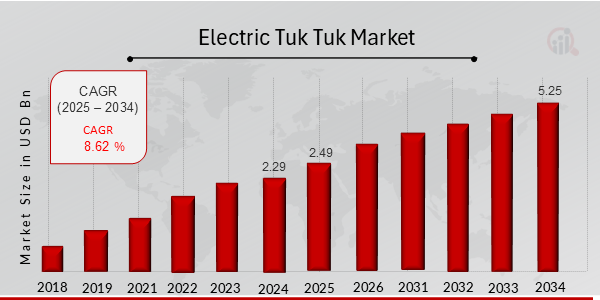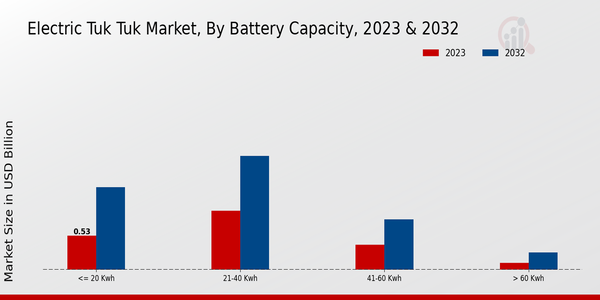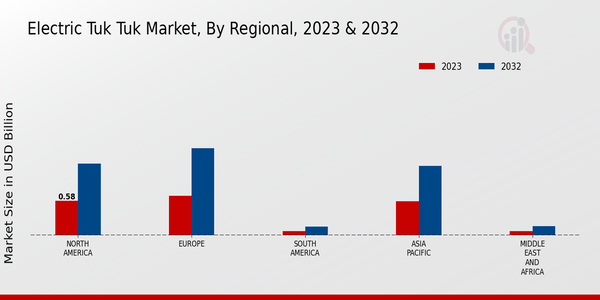Electric Tuk Tuk Market Overview:
As per MRFR analysis, the Electric Tuk Tuk Market Size was estimated at 2.29 (USD Billion) in 2024. The Electric Tuk Tuk Market Industry is expected to grow from 2.49 (USD Billion) in 2025 to 5.25 (USD Billion) till 2034, at a CAGR (growth rate) is expected to be around 8.62% during the forecast period (2025 - 2034).
Key Electric Tuk Tuk Market Trends Highlighted
The electric tuk-tuk market is experiencing increasing demand, driven by the rising popularity of electric vehicles, government initiatives promoting clean mobility, and the need for affordable and sustainable transportation solutions in urban areas. The compact size, low operating costs, and zero-emission nature of electric tuk-tuks make them an attractive option for both businesses and consumers.As governments worldwide set ambitious climate targets, the transition towards electric tuk-tuks is gaining momentum. Several countries have implemented policies and incentives to encourage the adoption of electric vehicles, including tax breaks, subsidies, and charging infrastructure development.
This favorable regulatory environment is expected to boost the growth of the electric tuk-tuk market in the coming years.Recent trends indicate a growing preference for high-speed electric tuk-tuks, which offer greater versatility and can operate outside of congested urban centers. Additionally, there is a growing demand for premium electric tuk-tuks with enhanced features, such as comfortable interiors, advanced safety systems, and extended range. These advancements cater to the evolving needs of customers who prioritize convenience, safety, and style.

Source: Primary Research, Secondary Research, MRFR Database and Analyst Review
Electric Tuk Tuk Market Drivers
Government Regulations and Incentives
Governments worldwide are implementing regulations and incentives to promote the adoption of electric vehicles, including electric tuk-tuks. These regulations and incentives aim to reduce emissions, improve air quality, and promote sustainable transportation. For instance, India has set a target to have 30% of all new vehicle sales to be electric by 2030. The government is providing subsidies and tax breaks to encourage the purchase and manufacturing of electric vehicles.Similarly, China has implemented a quota system for electric vehicle production and sales, requiring automakers to produce a certain percentage of electric vehicles each year. These regulations and incentives are expected to drive significant growth in the global electric tuk-tuk market over the forecast period.The rising demand for electric tuk-tuks is primarily driven by increasing government regulations and incentives aimed at promoting sustainable transportation.Governments worldwide are implementing stringent emission norms and regulations to curb air pollution and promote environmental sustainability.
As a result, there is a growing emphasis on adopting electric vehicles, including electric tuk-tuks, which produce zero tailpipe emissions.Moreover, governments are providing financial incentives, such as subsidies, tax credits, and rebates, to encourage the purchase and adoption of electric tuk-tuks. These incentives make electric tuk-tuks more affordable and accessible for consumers, further boosting their market demand. For instance, in India, the government offers a subsidy of up to INR 50,000 for the purchase of electric tuk-tuks. Similarly, in China, the government provides tax exemptions and reduced registration fees for electric vehicles, making them more cost-effective for consumers.
Technological Advancements
New technologies are already improving the performance and effectiveness of electric tuk-tuks. Batteries are technologically advancing fast, with new chemists offering higher energy densities, faster charge times, and longer ranges. Lithium-ion batteries are an example of devices that are already used in electric tuk-tuks because they possess high energy storage density and a long lifespan. In addition, solid-state batteries are also currently under development and will likely offer even higher energy densities than today’s battery variants.All in all, new battery technologies will likely provide several advantages for tuktuks, either increasing the units’ ranges or allowing them to use smaller batteries, which translates to weight and cost reduction.
Growing Urbanization and Traffic Congestion
Electric tuk-tuks are increasingly in demand due to the rapid growth of urbanization and the terrible transportation situation in cities all over the world. Tuk-tuks have already been considered a common and convenient means of transportation in many developing countries due to their low prices, ability to be used for delivering goods, and moving through narrow streets. The rapid growth of the city population and the number of cars increases the traffic on the road, and thus the pollution of the air. Many logistic and supply companies use electric tuk-tuks for delivering goods and products in urban areas since it is an economic and fast method.
Electric Tuk Tuk Market Segment Insights:
Electric Tuk Tuk Market Battery Capacity Insights
Battery Capacity is one of the most important segments of the Electric Tuk Tuk Market, which defines the nature of the products and impacts the market development. In 2023, the = 20 kWh battery capacity segment is one of the leaders with a notable market share. The advantages are easy on budget and can fit short-range applications. Nevertheless, in 2024, the 21-40 kWh segment is expected to grow: it is an optimum compromise between the range provided and the level of reliability. The 41-60 kWh battery capacity segment helps meet mid-range requirements and represents a valuable compromise between the range and the cost.
Thus, its market revenue will continue to grow. The > 60 kWh segment is one of the smallest with about 7% of the market share; however, in the next few years, the demand for long-range vehicles is expected to grow that will lead to the increasing popularity of the segment among the businesses working in the sphere of commerce and those related to tourism. To conclude, the Electric Tuk Tuk Market terrain by Battery Capacity helps to understand the trends that can be observed on this or that market and t he tastes and preferences of potential customers.This information will help market players predict the changes and adjust their products in the way that will be the most suitable for the given segment. It is possible to say that by relying on this demand, manufacturers can create products that will be the best fit for the needs and requirements of their customers.

Source: Primary Research, Secondary Research, MRFR Database and Analyst Review
Electric Tuk Tuk Market Passenger Capacity Insights
The Passenger Capacity segment of the Electric Tuk Tuk Market is divided into four sub-markets, which are “2-4”, “5-7”, “8-10”, and “> 10”. The “2-4” segment is projected to hold the largest market share in 2024, amounting to approximately 45% of the Electric Tuk Tuk Market Revenues. The following share is expected for the “5-7” segment, which is supposed to hold roughly 30% of the market. The “8-10” Passenger Capacity segment is expected to hold about 20% of the market share and “> 10” segment is expected to hold approximately 5% of the market share.
The expected growth of “2-4” is associated with the constantly increasing demand for compact and easily maneuverable Electric Tuk-Tuk in urban areas for short-distance road travel. These types of vehicles are exceptionally popular in developing countries where it constitutes a cheap and eco-friendly alternative to usual gasoline tuk-tuks and cars. The next in line, “5-7” and “8-10” segments are also expected to grow rapidly as the use of Electric Tuk-Tuk as a means of road travel for tourism and commercial purposes grows in popularity, providing a delicious mix of comfort and financial convenience.
Electric Tuk Tuk Market Vehicle Type Insights
The Vehicle Type segment in the Electric Tuk Tuk Market is categorized into Passenger, Cargo, Convertible, and Special Purpose Vehicles. The Passenger sub-segment held the largest market share in 2023, accounting for over 60% of the Electric Tuk Tuk Market revenue. This growth is attributed to the increasing demand for affordable and eco-friendly transportation options, particularly in emerging economies. The Cargo sub-segment is projected to witness significant growth in the coming years, driven by the rising e-commerce industry and the need for efficient last-mile delivery solutions. Convertible and Special Purpose Vehicles are expected to contribute a smaller but growing share to the overall market.
Electric Tuk Tuk Market Battery Type Insights
The Battery Type segment is a crucial aspect of the Electric Tuk Tuk Market, contributing significantly to its overall market dynamics. Lead-Acid Batteries currently dominate the segment, holding a major market share due to their low cost and established production infrastructure. However, Lithium-Ion Batteries are gaining traction owing to their higher energy density and longer lifespan, leading to increased adoption in high-performance electric tuk-tuks. Sodium-Ion Batteries are emerging as a promising alternative, offering a combination of low cost and improved performance compared to Lead-Acid Batteries.This segment is expected to witness significant growth in the coming years, driven by the increasing demand for efficient and sustainable electric tuk-tuks.
Electric Tuk Tuk Market Drive System Insights
The Drive System segment is a crucial aspect of the Electric Tuk Tuk Market, influencing its performance and efficiency. Single Hub Motors remain the most popular choice, accounting for approximately 55% of the market share in 2023. Their cost-effectiveness and simplicity make them suitable for budget-conscious consumers and entry-level models. Dual Hub Motors follow closely with a 30% market share, offering enhanced traction and stability, particularly in hilly or challenging terrains. Four Wheel Drive systems, though currently holding a smaller market share of around 15%, are gaining traction due to their superior off-road capabilities and increased safety features.As the Electric Tuk Tuk Market continues to expand, the demand for more powerful and efficient drive systems is expected to drive the growth of the Dual Hub Motor and Four Wheel Drive segments, leading to a projected market revenue of USD 2.5 billion by 2026.
Electric Tuk Tuk Market Regional Insights
The regional segmentation of the Electric Tuk Tuk Market includes North America, Europe, APAC, South America, and MEA. The APAC region is expected to hold the largest market share in 2023, owing to the increasing demand for electric vehicles in countries like China and India. The market in North America is also expected to grow significantly, driven by the rising adoption of electric vehicles in countries like the US and Canada. Europe is another key region for the Electric Tuk Tuk Market, with countries like Germany and the UK showing strong growth potential.South America and MEA are expected to witness moderate growth in the coming years, as the demand for electric vehicles in these regions is still in its early stages.

Source: Primary Research, Secondary Research, MRFR Database and Analyst Review
Electric Tuk Tuk Market Key Players And Competitive Insights:
Major players in Electric Tuk Tuk Market industry are constantly engaged in research and development activities to enhance their product offerings and gain a competitive edge in the market. Leading Electric Tuk Tuk Market players are focusing on strategies such as product innovation, strategic partnerships, and acquisitions to expand their market presence and strengthen their position in the industry. Electric Tuk Tuk Market development is driven by the increasing demand for environmentally friendly and cost-effective transportation solutions, particularly in developing countries.
The competitive landscape of the Electric Tuk Tuk Market is characterized by both local and international players, with varying degrees of market share and influence.A leading player in the Electric Tuk Tuk Market is Bajaj Auto, which has a strong presence in India and other emerging markets. The company offers a range of electric tuk-tuks under its RE brand, which are known for their durability, affordability, and low operating costs. Bajaj Auto has a well-established distribution network and a strong brand reputation, which enables it to reach a wide customer base.
The company is also actively involved in research and development, and it has recently launched new electric tuk-tuk models with improved performance and features.A competitor in the Electric Tuk Tuk Market is Mahindra Electric, which is another Indian company with a strong presence in the domestic market. Mahindra Electric offers a range of electric tuk-tuks under its Treo brand, which are known for their advanced technology and environmentally friendly features. The company has a strong focus on sustainability, and it has been recognized for its efforts in promoting electric mobility. Mahindra Electric has a wide distribution network and a strong brand reputation, which enables it to reach a large customer base. The company is also actively involved in research and development, and it has recently launched new electric tuk-tuk models with improved performance and features.
Key Companies in the Electric Tuk Tuk Market Include:
- Bajaj Auto
- Mahindra Mahindra
- BYD Auto
- OMA Electric Mobility
- Saera Electric Auto
- MTW
- Chetak Vehicles
- Piaggio Group
- TONBO
- Micro Mobility Systems
- Okinawa Autotech
- Olectra Greentech
- Tork Motors
- Hero Electric
- Altigreen Propulsion Labs
Electric Tuk Tuk Industry Developments
Bajaj Auto
February, 2025: Bajaj Auto announced the launch of its new electric tuk-tuk model, the Bajaj RE EV, which boasts an extended range of 120 km on a single charge.
March, 2025: The company reported a partnership with a leading battery manufacturer to enhance the battery technology used in their electric vehicles.
Mahindra Mahindra
January, 2025: Mahindra unveiled its latest electric tuk-tuk, the Mahindra Treo Zor, emphasizing its eco-friendly features and lower operational costs.
April, 2025: The company announced plans to increase its production capacity for electric vehicles by 30% in response to rising demand.
BYD Auto
March, 2025: BYD launched its electric tuk-tuk, the BYD eTuk, aimed at urban transportation markets in Asia, featuring advanced safety features and smart connectivity.
April, 2025: The company signed a memorandum of understanding (MoU) with several local governments in India to promote electric mobility solutions, including tuk-tuks.
The global electric tuk-tuk market is anticipated to grow significantly in the coming years. The market is projected to reach a valuation of USD 5.25 billion by 2034, exhibiting a CAGR of 8.62% during the forecast period of 2025 - 2034. Rising environmental concerns, increasing urbanization, and government initiatives promoting electric vehicles are key factors driving market growth. Major players in the market include Mahindra Electric, Bajaj Auto, and Piaggio. Recent developments include the launch of new electric tuk-tuk models with advanced features and the expansion of charging infrastructure in developing countries.
Electric Tuk Tuk Market Segmentation Insights
Electric Tuk Tuk Market Battery Capacity Outlook
- = 20 kWh
- 21-40 kWh
- 41-60 kWh
- > 60 kWh
Electric Tuk Tuk Market Passenger Capacity Outlook
Electric Tuk Tuk Market Vehicle Type Outlook
- Passenger
- Cargo
- Convertible
- Special Purpose Vehicles
Electric Tuk Tuk Market Battery Type Outlook
- Lead-Acid Batteries
- Lithium-Ion Batteries
- Sodium-Ion Batteries
Electric Tuk Tuk Market Drive System Outlook
- Single Hub Motor
- Dual Hub Motor
- Four Wheel Drive
Electric Tuk Tuk Market Regional Outlook
- North America
- Europe
- South America
- Asia Pacific
- Middle East and Africa
| Report Attribute/Metric |
Details |
|
Market Size 2024
|
2.29 (USD Billion)
|
|
Market Size 2025
|
2.49 (USD Billion)
|
|
Market Size 2034
|
5.25 (USD Billion)
|
|
Compound Annual Growth Rate (CAGR)
|
8.62% (2025 - 2034)
|
|
Report Coverage
|
Revenue Forecast, Competitive Landscape, Growth Factors, and Trends
|
|
Base Year
|
2024
|
|
Market Forecast Period
|
2025 - 2034
|
|
Historical Data
|
2019 - 2023
|
| Market Forecast Units |
USD Billion |
| Key Companies Profiled |
Bajaj Auto, Mahindra Mahindra, BYD Auto, OMA Electric Mobility, Saera Electric Auto, MTW, Chetak Vehicles, Piaggio Group, TONBO, Micro Mobility Systems, Okinawa Autotech, Olectra Greentech, Tork Motors, Hero Electric, Altigreen Propulsion Labs |
| Segments Covered |
Battery Capacity, Passenger Capacity, Vehicle Type, Battery Type, Drive System, Regional |
| Key Market Opportunities |
Increasing urbanization rising fuel costs government incentives growing environmental concerns technological advancements |
| Key Market Dynamics |
Growing urbanization Government initiatives Rising fuel prices Increasing environmental concerns Technological advancements |
| Countries Covered |
North America, Europe, APAC, South America, MEA |
Frequently Asked Questions (FAQ) :
The global electric tuk-tuk market is projected to expand at a CAGR of approximately 8.62% from 2025 to 2034.
In 2025, the global electric tuk-tuk market is estimated to be valued at around 2.49 billion USD.
The global electric tuk-tuk market is projected to reach a valuation of approximately 5.25 billion USD by 2034.
The Asia-Pacific region is expected to dominate the global electric tuk-tuk market throughout the forecast period.
Rising fuel prices, increasing environmental concerns, and government initiatives promoting electric vehicles are key factors driving market expansion.
Major players in the global electric tuk-tuk market include Mahindra Electric, Bajaj Auto, and Piaggio.
Electric tuk-tuks are primarily used for last-mile connectivity, public transportation, and goods delivery.
The organized sector is anticipated to account for a significant share of the global electric tuk-tuk market, owing to the presence of established manufacturers and distributors.
Developing countries are expected to present substantial growth opportunities for the electric tuk-tuk market due to increasing urbanization and the need for affordable and sustainable transportation solutions.
Challenges include limited charging infrastructure, high battery costs, and competition from traditional fuel-powered tuk-tuks.

















